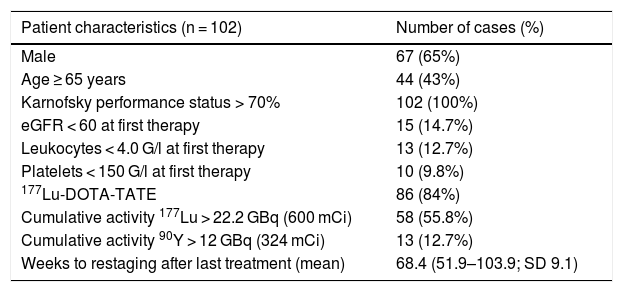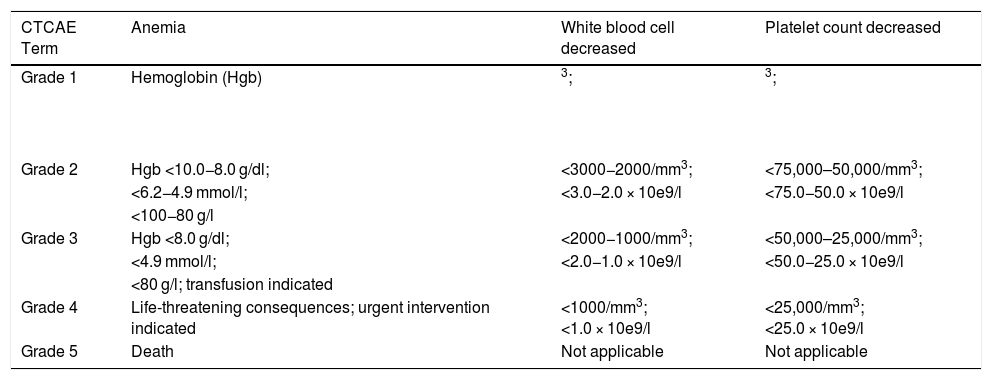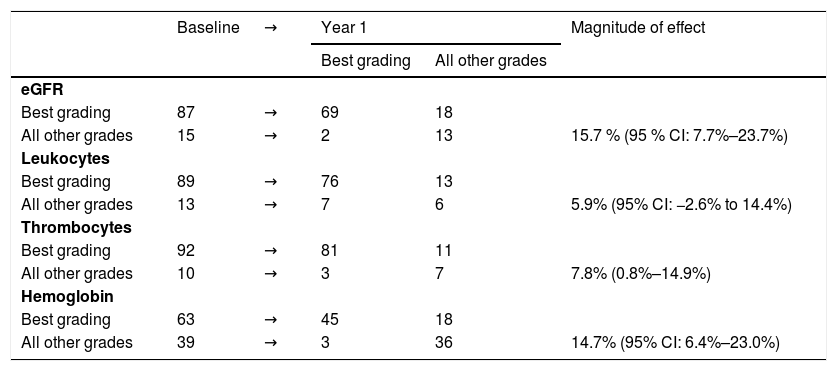Nephro- and hematotoxicity after peptide receptor radionuclide therapy (PRRT) have been described in multiple studies with heterogeneous cumulative activities, number of cycles or radiolabelled peptides. Though highly differentiated metastasized neuroendocrine tumours (NET) have long progression free survival, they may progress. We analysed long-term side effects in a homogenous treatment schedule in PRRT-patients and their impact on future oncologic treatment in case of progression.
MethodsFrom our database 89/384 patients receiving the same PRRT (Lu-177-DOTATATE or Y-90-DOTATOC) 4 times every 10–12 weeks and a follow-up at 12 months were analysed. One patient had three and 11 patients had two times four PRRT-cycles resulting in 102 cases. eGFR, Hb, WBC and platelets before the first and one year after the fourth therapy cycle were compared. eGFR-Grading was done according to chronic kidney disease classification (CKD) and grading of hematotoxicity according to CTCAE. Impact of age, gender, cumulative activity, type of PRRT on long-term-toxicity was also assessed.
ResultseGFR grade 1–2 dropped from 87/102 at the baseline to 71 cases at follow-up (p < 0.001). Before treatment grade 3a was found in 13, grade 3b in 2 cases, and at follow-up grade 3a in 25, grade 3b in 5, and grade 4 in 1 case. Anaemia prior to PRRT and at follow-up was grade 0 in 63 versus 48 (p < 0.001), grade 1 in 36 versus 48, and grade 2 in three versus six cases. In white blood cell count and platelets, there were no significant changes in grading occurring. Subgroup analysis revealed that only in the age group 65 and older was there a higher incidence for anaemia (p = 0.006).
ConclusionIn roughly 20% of cases an increase in grading of nephro- or hematotoxicity is observed. In those patients, except in one, toxicity findings were mild or moderate one year after completion of four cycles of PRRT with either Y-90- or Lu-177-SST-analogues. In terms of safety, PRRT has no critical impact on further oncologic treatment options in the case of disease progression.
La nefrotoxicidad y la hematotoxicidad después de la terapia con péptidos marcados con radionúclidos (PRRT) se han descrito en múltiples estudios usando diferentes actividades acumulativas, número de ciclos o péptidos marcados con radionúclidos. Aunque los tumores neuroendocrinos (NET) altamente diferenciados con metástasis tienen una larga supervivencia libre de progresión, pueden progresar. Analizamos los efectos secundarios a largo plazo en un esquema de tratamiento homogéneo en pacientes con PRRT y su impacto en el futuro tratamiento oncológico en caso de progresión.
MétodosDe nuestra base de datos se analizaron 89/384 pacientes que recibieron la misma PRRT (Lu-177-DOTATATE o Y-90-DOTATOC) 4 veces cada 10 a 12 semanas y un seguimiento a los 12 meses. Un paciente recibió tres y 11 pacientes recibieron dos veces cuatro ciclos de PRRT, lo que dio lugar a 102 casos. Se compararon la TFG, la Hb, los glóbulos blancos y las plaquetas antes del primer ciclo de terapia y un año después del cuarto ciclo. La clasificación de la TFG se realizó según la clasificación de la enfermedad renal crónica (ERC) y la clasificación de la hematotoxicidad según el CTCAE. También se evaluó el impacto de la edad, el sexo, la actividad acumulada y el tipo de PRRT en la toxicidad a largo plazo.
ResultadosEl grado 1–2 de la TFG se redujo de 87/102 al inicio a 71 casos en el seguimiento (p < 0,001). Antes del tratamiento se encontró grado 3a en 13, grado 3b en 2, y en el seguimiento grado 3a en 25, grado 3b en 5 casos, y grado 4 en 1 caso. La anemia antes de la PRRT y en el seguimiento fue de grado 0 en 63 versus 48 (p < 0,001), de grado 1 en 36 versus 48, y de grado 2 en tres versus seis casos. En el recuento de glóbulos blancos y plaquetas no se produjeron cambios significativos en la clasificación. El análisis de subgrupos reveló que sólo en el grupo de edad de 65 años o más hubo una mayor incidencia de anemia (p = 0,006).
ConclusiónEn aproximadamente 20% de los casos se observa un aumento de la gradación de la nefrotoxicidad o hematotoxicidad. En estos pacientes, excepto en uno, los niveles de toxicidad fueron leves o moderados un año después de completar cuatro ciclos de PRRT con análogos de Y-90 o Lu-177-SST. En términos de seguridad, la PRRT no tiene un impacto crítico en las opciones de tratamiento oncológico posterior en caso de progresión de la enfermedad.
Article

Revista Española de Medicina Nuclear e Imagen Molecular (English Edition)














